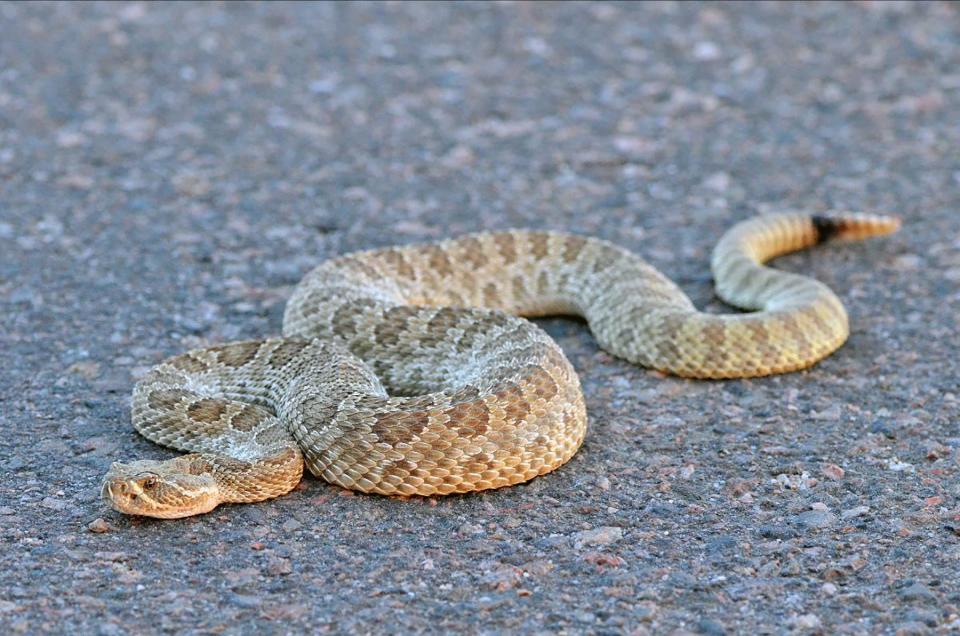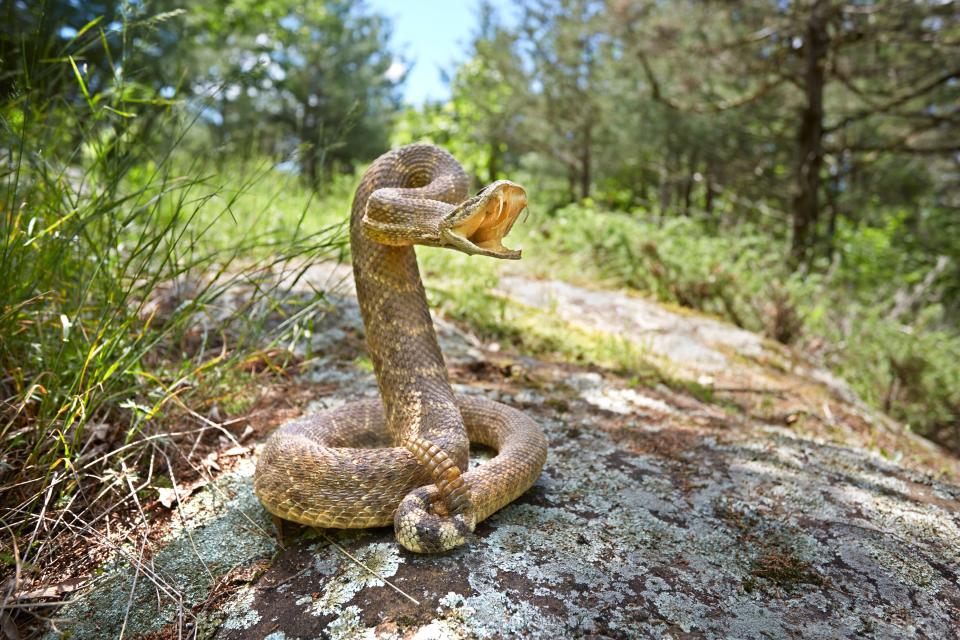How to avoid rattlesnakes in Pueblo and what to do if you come across one
Daily pleas for help removing and identifying rattlesnakes have been rampant on Facebook pages like “I Live in Pueblo West” and “Helping Pueblo” this summer.
Homeowners fear venomous snakes could strike their children and pets.
Recently, an 11-year old boy was bitten by a rattlesnake during a biking accident near Golden. He survived thanks to his father’s quick action, according to a Colorado Parks and Wildlife press release.
State wildlife experts say that most of the time, rattlesnakes will not strike at people unless they feel threatened or are deliberately provoked. Attacks on people are rare and usually not fatal for a healthy adult but can be more dangerous for children and pets due to their smaller size.
What to know about rattlesnake behavior
Snakes are often seen during the spring and fall when cool temperatures require them to bask in the sun on warm surfaces such as pavement or rocks near trails or roads.
During the summer, rattlesnakes use camouflage to blend in with their surroundings and in most cases will ignore people, thinking they cannot be seen. They tend to hunt starting in the early afternoon and into the evening when temperatures are warm.

Stay aware and protect yourself in areas where rattlesnakes live
The state wildlife service advises you to always be aware of your surroundings by using your eyes and ears. Do not hike using headphones or earbuds so you can hear a rattlesnake’s distinctive warning rattle.
Watch for snakes basking in open, sunny areas such as pavement, rocks, trails or roads. Walk off trail to avoid them.
You should also watch where you place your hands and feet at all times, especially near rocks or logs that could be sheltering a rattlesnake. Feet and ankles should be protected, as they are usually closest to rattlesnakes. Sturdy leather boots afford good protection; do not hike in sandals or flip flops.
What to do if you encounter a rattlesnake
Colorado Parks and Wildlife indicates the best thing you can do if you encounter a rattlesnake is to freeze in place. Snakes are often heard before they are seen and attempting to move away from a snake you can’t see may lead you closer to it. Even if the snake is in plain view, freezing movement will reduce the threat you pose to the snake and help you calmly assess the situation.
If a snake coils up, or makes a rattle noise, you are too close and should move away slowly. Stepping back just a few feet can convince the snake you are not a threat. A good rule of thumb is to put at least 5 feet between yourself and the snake. If possible, move slowly back the way you came.
If you find a snake in your home or garage, call your local wildlife office for directions. In urban areas, many pest control companies can remove them for you.
How to keep your pets safe
The best way to keep your pets safe from rattlesnakes is to keep them on a leash. Dogs in particular are known to be very curious animals that ignore a snake's defensive posturing. If you live in an area where rattlesnakes are common and must let your pets outside, try to eliminate rock piles or grassy areas that could harbor snakes or common prey. Do a quick patrol of the area before letting your pets roam free. Many dog training facilities in Colorado offer snake avoidance training for dogs, teaching them to avoid the sight, scent and sound of a snake.
According to the Southern Colorado Kennel Club, there are two nearby options for information on rattlesnake avoidance for dogs: Nora Birt of Best Dog, in Monument, offers positive-based snake aversion training while Colorado Gun Dog Association offers a more assertive training using electric collars. The agency offers just one training a year, the next of which is tentatively set for June 1, 2024.
In the event of a bite, seek immediate veterinary attention and call the clinic ahead of time.
What to do if you're bitten by a rattlesnake

Rattlesnakes are Colorado's only native poisonous snake. According to the Colorado Poison Center, if bitten by a rattlesnake you should call the Poison Center at 1-800-222-1222 for instructions, then go to the nearest hospital. Remove any jewelry and tight-fitting clothing, stay calm and avoid excess movement.
Do not cut and try to extract venom and do not apply ice, heat or a tourniquet. You should also not attempt to suck out the venom, according to the Centers for Disease Control and Prevention.
In all cases of snake encounters, you should not try to kill or capture the snake. However, in Colorado, rattlesnakes may be legally killed if they pose a threat. All other snakes are classified as nongame wildlife and are protected by law, according to Colorado Parks and Wildlife.
More on snakes in Pueblo: Snakes alive!
Chieftain reporter Tracy Harmon covers business news. She can be reached by email at tharmon@chieftain.com or via Twitter at twitter.com/tracywumps. Support local news, subscribe to The Pueblo Chieftain at subscribe.chieftain.com
This article originally appeared on The Pueblo Chieftain: How to avoid rattlesnakes in Colorado and what to do if you're bitten

